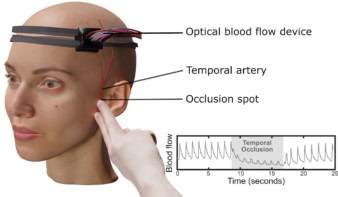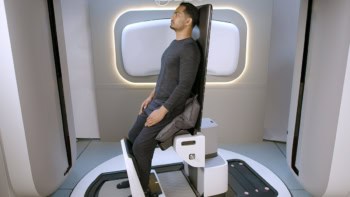A practical, portable ultralow-field magnetic resonance imaging (MRI) system has been unveiled by researchers from the Los Alamos National Laboratory in the US. With its low power requirements and lightweight construction, the researchers hope that their prototype design can soon be deployed for use in medical centres in developing countries as well as in military field hospitals.
MRI is a powerful medical diagnostic tool, which can be applied to the detailed imaging of a variety of soft tissues, in particular the brain. MRI scanners work by using large, powerful magnets to align the protons (hydrogen atoms) in water molecules. Short bursts of radio waves are then used to excite the protons, which as they relax give off weak radio waves the scanner can detect. Image contrast is provided by the varying relaxation times between different tissue types. Despite their usefulness, however, conventional MRI systems require both a considerable source of power and a supply of cryogens, such as helium or liquid nitrogen, to keep the magnets cool and functioning. On top of that, they are expensive to build and bulky to house.
Scaling down
“Standard MRI machines just can’t go everywhere,” explains project leader Michelle Espy, a physicist at Los Alamos. “Soldiers wounded in battle usually have to be flown in to a large hospital – and people in emerging nations just don’t have access to MRI at all.”
To scale down the scanners, Espy and her team have made use of ultralow magnetic fields, which have intensities comparable to that of the Earth’s magnetic field, to develop what they call “battlefield MRI” (bMRI). To detect the much weaker signals, their machine uses a superconducting quantum interference device (SQUID), which acts as an extremely sensitive magnetometer. While previous research has demonstrated the potential of ultralow-field MRI scanners, it has been limited by poor image qualities, long imaging times and – most critically – an impractical need to operate in an environment almost entirely isolated from ambient electromagnetic noise. “SQUIDs are so sensitive they’ll respond to a truck driving by outside, or a radio signal from 50 miles away,” explains Al Urbaitis, an engineer at Los Alamos.
To combat potential sources of interference, the team built its first prototype device within a large metal enclosure, which acted as a shield. The researchers scanned the brains of human test subjects, producing images with a special resolution of 2.1 × 2.4 mm2, with a 15 mm slice thickness. Having used this set-up to demonstrate their machine’s potential, the researchers have now switched to developing a second iteration of the device that works in an open environment. In the new design, shielding is offered by a series of lightweight wire coils, which encircle the scanner. Currently, the coils only compensate for the Earth’s magnetic field, but the team is confident the shielding can be enhanced to cancel out additional interference on the fly.
Clear imagery
“We’ve been very happy with some of the initial imagery that’s been produced from the lightweight, second-generation system,” says Espy, adding that “with additional development, these systems could be relatively easy and inexpensive to deploy”.
The team has been working towards a military medical application, but is also investigating the potential benefits the device could provide in developing countries that do not have access to conventional MRI. In addition, ultralow-field MRIs also have the potential to be used in situations where – because of the powerful magnets – conventional MRI is not suitable. For example, an ultralow-field machine could be used in emergency situations where metal cannot practically be excluded from the scanning environment.
“The ultralow-field MRI images presented by [the researchers] are very impressive and encouraging for all other groups working along similar lines of research,” says Peter Blümler, a physicist from Johannes Gutenberg University Mainz in Germany, who is not a part of the Los Alamos team. He adds “Personally, I do not see portable MRI systems replacing the high-field equipment, but rather complementing the diagnostic potential of magnetic resonance.” Mark Cohen, a bioengineer from UCLA in the US who was also not involved in this study, is impressed with the work, especially as it represents the first practical test of the principle at the scale of a true human imaging system.
The research is described in IEEE Transactions on Superconductivity.



